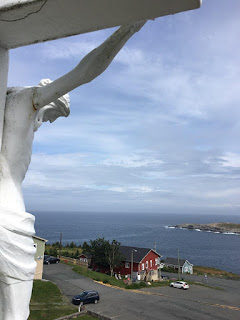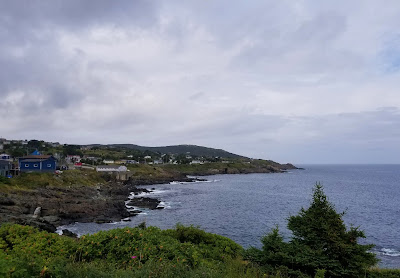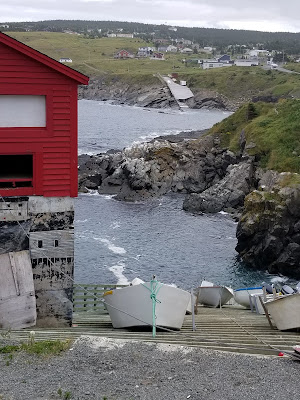#47 St. John’s
Tuesday Aug. 27, 2019
It is only 27 miles
from Holyrood to St. Johns. The wind was still blowing and the rain sprinkled
the windshield. We set up and then I
needed to visit a walk in clinic to get some antibiotics. I was done for today.
Wednesday Aug. 28
Feel good today so I
checked out our itinerary. Costco in
St. John’s: closed permanently according to Google. Had I checked out Mount Pearl, it was
there. But we decided to skip it until
we find one state side. (We did go to one
in Fredricton, New Brunswick because there is no Costco in Maine, only one in
South Dakota, etc. didn’t know we could
find the next one.)
Next we went to physically checkout the
laundromats. We found three in the area,
but none of which we wanted to use.
Laundry will have to be done at the park.
Next we drove north of St. John’s. We found two interesting places. One is Flatrock (pop. 1683). It didn’t look that big. We saw a flat rock on the side of the hill, but couldn’t find if that was the town name origin.
The harbor was loaded with seagulls. Derrille and Jay were looking for a trail and talked with the locals. The” beams” could only be reached by walking the trail. The locals also said not to miss the Grotto up the road.
We have seen three
Lady of Lourdes Grottoes on this trip. Each one very different.
This one has the Stations of the Cross climb a rock staircase that looks a bit like I imagine Jerusalem may have looked like.
Statues and plaques are placed in memory of someone.
The amazing plaque is on the spot where Pope John Paul II knelt in this grotto. It sits right in the path way to the grotto.
A memorial opposite
the Grotto marks the spot where Pope John Paul II blessed the fleet. The fleet in the behind the photo of the Pope are sitting in the harbor in the shape of a cross. It was
amazing that the pope even came to this tiny town of Flatrock on the Newfoundland coast!
However the priest for this church did spend some time in Rome.
As we looked across the bay the structures at the end of the rocks looks like “beams”, maybe that is what the locals were talking about.
The lady that we met at Maryvale, said to be sure and co me to Pouch Cove to see the beauty there. So we did. The bay sits well below the cove road. Waves crashed against the shores below.
Then we saw this marina!!! The ramp sits at about a 30 degree angle. Fascinating!
Boats are raised or lowered down this ramp.
We stood watching the
wave action on the rocks just around the corner from the “marina”.
Thursday Aug. 29,
2019
It was raining again
so we did laundry. These people are making a phone call. We were surprised to see so many outdoor
telephone booths in operation. Jay and Lynn did their laundry last night. Then
we took off to see what The Rooms had to offer.
The museum has four floors: three of exhibits and one for admin and the gift shop. We started on four and worked our way down.
A large display explained the Irish immigration to Newfoundland and their Roman Catholic religion. The Irish made up a huge part of immigrates here. They also spoke of a time when the Catholics were forbidden to practice their faith here. Then how the two groups came to peace with each other. I appreciated an exhibit on Latin as a language. There were a couple of art galleries too.
Level Three had a big exhibit that told of the early people here. Several large dioramas depicted the various aboriginal groups of people that arrived here from different directions on the map. It showed how they lived and with the help of a timeline it traced their time here in years. It had an exhibit of the stone quarry we saw in Fleur d Lys. It had a display on the Basques that we have seen in several other places. (Don’t know what happened to these photos????)
I found the display of a Giant Squid well done. It did mention that in 2006 someone was able to photograph a live Giant Squid. So we added to our knowledge bank.
It had displays of sea birds, fossils and stuffed animals. We saw the big white birds, Gannets when we were on the whale tour in St. Anthony's. We saw the puffins at Bonavista and the caribou at Port au Chois.
There was a small
exhibit on airplanes.
This hands-on exhibit allows you to build a whale skeleton from the bones in the boxes.
Level Two had an
exhibit on Newfoundland sayings and what they mean. That was fun.
The main exhibit on this floor showed Newfoundland’s part in World Wars from 1914-1949. It starts with pictures of people who served and gives a little bio on the back. This young man’s bio is on the side. Most were young men and women. Many were just boys 16-19 years old.
It went through the
training, and the battles. The
Newfoundlanders became the Caribou Regiment of the British army.
The trail of the
Caribou took these young people taught them new skills and then took them through many battles.
The Danger Tree
traditionally holds that it was halfway between the two lines, and marked the
furthest advancement of the Newfoundlanders.
It became a symbol of what was achieved and what was lost.
Frances Cluett a
former teacher volunteered in 1916 and worked as a nurse. She found time to
paint and photograph her surroundings.
After the war she returned to teaching.
Some served defending the home front. Some had specialty jobs.
Some young men served in the Forestry Corps to supply the timber needed for trench supports, walkways and railroad ties. 500 from Newfoundland/Labrador served, including some too old or medically unfit for fighting duty.
A section showed the price that was paid after the war ended. The lost body parts. Their jobs were gone, or they were no longer capable of doing their jobs etc.
The Penny for a Life exhibit showed the “penny” plaques sent to every family in the British Empire who lost a loved one. They copied the one-cent coins of the day. The plaques soon became known as
death pennies”. No ranks were used, making all deaths equal.
A Contemplative
section reminded us to think about the consequences of war. How do you measure the cost of war? How can paper and medals stand for the loved one now gone? The number of wounded or dead was staggering.
Sable Chief was my favorite part of the exhibit. I like the way dogs in service are respected.
The rest was very sobering and moved the
emotions. The whole exhibit was very
well presented.
Tomorrow Belle Island










































































No comments:
Post a Comment